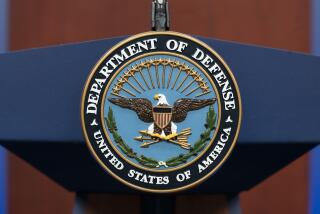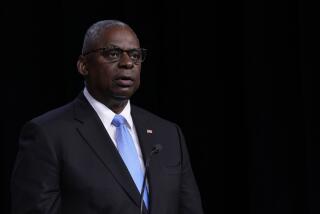Air Force’s role in Iraq could grow
WASHINGTON — The Air Force is preparing for an expanded role in Iraq that could include aggressive new tactics designed to deter Iranian assistance to Iraqi militants, senior Pentagon officials said.
The efforts could include more forceful patrols by Air Force and Navy fighter planes along the Iran-Iraq border to counter the smuggling of bomb supplies from Iran, a senior Pentagon official said. He spoke on condition of anonymity because he was discussing future military plans.
Such missions also could position the Air Force to strike suspected bomb suppliers inside Iraq to deter Iranian agents that U.S. officials say are assisting Iraqi militias, outside military experts said.
The heightened role of U.S. air power in the volatile region is the latest sign of tension between President Bush and Iran’s leaders.
Bush warned two weeks ago that U.S. forces would take a harder line against Iranians in Iraq, vowing to “seek out and destroy” weapons supply networks that endanger U.S. troops.
He expanded the warning Monday, saying in a National Public Radio interview that Iranian threats to the Iraqi people would be considered unacceptable.
The tough stance has been backed by military moves. Bush this month ordered a second aircraft carrier group, led by the John C. Stennis, to the Persian Gulf, a measure described as a warning to Iran.
The stepped-up presence and visibility of U.S. warplanes is seen as likely to reinforce that message.
“Air power plays major roles, and one of those is as a deterrent, whether it be in border control, air sovereignty or something more kinetic,” said the senior Pentagon official, using a term that refers to offensive military action.
But the White House rhetoric on Iran is fueling concern about administration intentions.
Senate Foreign Relations Committee Chairman Joseph R. Biden Jr. (D-Del.) has demanded to know the administration’s view of its authority to attack Iran. Bush and Defense Secretary Robert M. Gates have said they do not foresee military action crossing into Iran.
Within the Pentagon, many active-duty officers are wary of an aggressive military response to Iran, arguing that there is no need to risk starting another war.
Some Pentagon officials worry that an escalation of military pressure that included strikes on Iranian territory could prompt Iran to go after targets it could easily hit, such as oil tankers in the Persian Gulf.
“We need to be very careful about getting into one-to-one trades,” the senior Pentagon official said. “That can very quickly get out of control.”
Other military officers argue there may be no need for “kinetic” strikes. It is possible that stepped-up air operations over Iraq could provide a deterrent, they say.
The Air Force already is gearing up for just such a role in Iraq as part of Bush’s planned troop increase, said a senior service official who spoke on condition of anonymity.
Moving additional forces to Kuwait and Iraq will require more flights of troops and supplies. And the increased number of ground forces will require more missions by fighter jets, bombers and intelligence-gathering planes to help protect the soldiers and Marines, particularly when they disperse from bigger bases to footholds in dense Baghdad neighborhoods.
“You will see the full spectrum of capabilities all the way from intelligence, surveillance and reconnaissance capability to kinetic effects,” said Lt. Gen. Howie Chandler, the deputy Air Force chief of staff for operations, plans and requirements.
In Afghanistan, the United States has dramatically stepped up its airstrikes, from 157 in 2005 to 2,527 in the first 11 months of 2006. By contrast, the number of airstrikes in Iraq has fallen, from 306 in 2005 to 188 last year.
U.S. commanders have not spelled out a precise role for the Air Force under the new approach in Iraq, which will focus on counterinsurgency strategies.
Some Air Force officers are concerned that incoming commanders do not recognize the importance of the Air Force in the new effort.
A counterinsurgency manual developed by Army Gen. David H. Petraeus, the new U.S. commander in Iraq, only briefly mentions air power in fighting the insurgency. And the commander of day-to-day operations, Army Lt. Gen. Raymond T. Odierno, comes from a background in heavy infantry units, traditionally less dependent on air power.
Some military officers have argued that dropping bombs in dense Baghdad neighborhoods would be counterproductive, and Petraeus has warned commanders against operations that might alienate the local population.
Chandler said the Air Force would do as it was asked. But he and other Air Force officials argue that smaller bombs and precision guidance systems can minimize civilian casualties and play a vital role in fighting the insurgency.
“I wouldn’t automatically write off air power in an urban environment for fear of collateral damage,” Chandler said. “We have the capability with precision targeting and the new weapons to operate in an urban environment.”
Air Force officials say they also are preparing to increase flights of unmanned Predator and Global Hawk aircraft to provide constant surveillance of Baghdad neighborhoods when U.S. forces move in.
The Air Force has outfitted its fighter planes with intelligence pods capable of beaming an aerial picture of a neighborhood to a ground commander maneuvering his forces, Chandler said.
Chandler said it was not clear whether the new demands would require more planes. But a Pentagon official said that the increase in ground forces was likely to increase the demand for air support, straining the Air Force budget.
The growing presence of the Air Force in the region has stirred a debate among military experts over the U.S. approach toward Iran.
Thomas G. McInerney, a retired Air Force lieutenant general who advocates military strikes in Iran, said U.S. planes along the border could be better used to keep bomb-making materials out of Iraq.
“We know they are doing this. Why do we accept it?” McInerney said. “For every [improvised explosive device] that goes off in Iraq, a bomb should go off in Iran.”
Loren Thompson, a military analyst at the Lexington Institute, said many military targets in Iran were susceptible to Air Force weapons.
“Iran is precisely the type of enemy they know how to deal with,” Thompson said. “Having the ability to attack Iranian military targets and political targets is not just a deterrent. It may actually be used if we feel the Iranians are trying to subvert democracy in Iraq.”
U.S. planes could be in the region for years. Although the U.S.-led war in Iraq began in 2003, Air Force officials note that American fighter planes have flown over Iraq for more than a decade.
When the 1991 Persian Gulf War ended, fighter planes remained in the region, enforcing no-fly zones and essentially conducting an air occupation.
Once the Iraq war starts to wind down, Air Force officials say, the service’s presence will still be required to provide firepower and surveillance to Iraqi units.
“We do know we have been there for 16 years,” Chandler said, “and we will be there as long as we can see into the future.”
*
Times staff writer Peter Spiegel in Washington contributed to this report.
More to Read
Sign up for Essential California
The most important California stories and recommendations in your inbox every morning.
You may occasionally receive promotional content from the Los Angeles Times.










